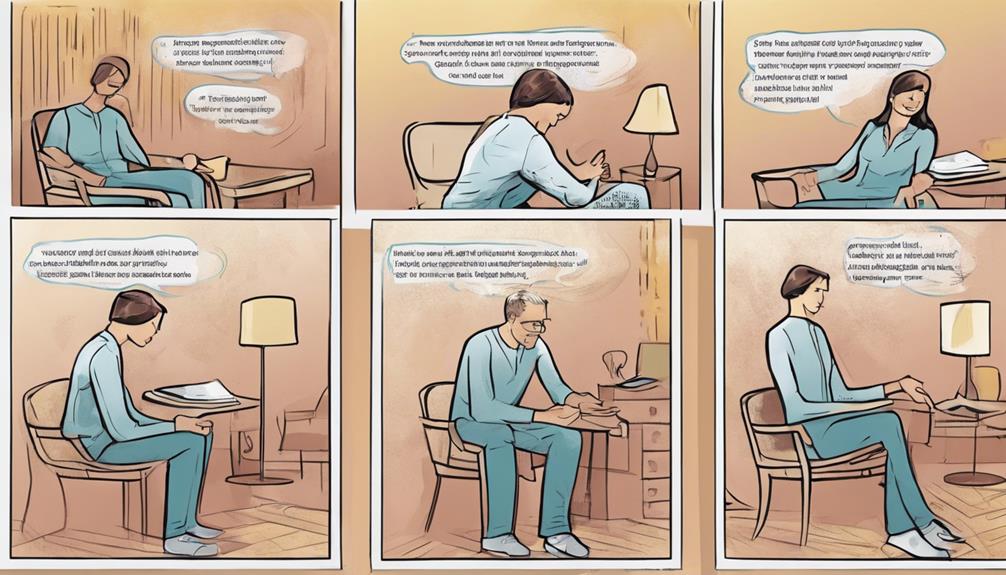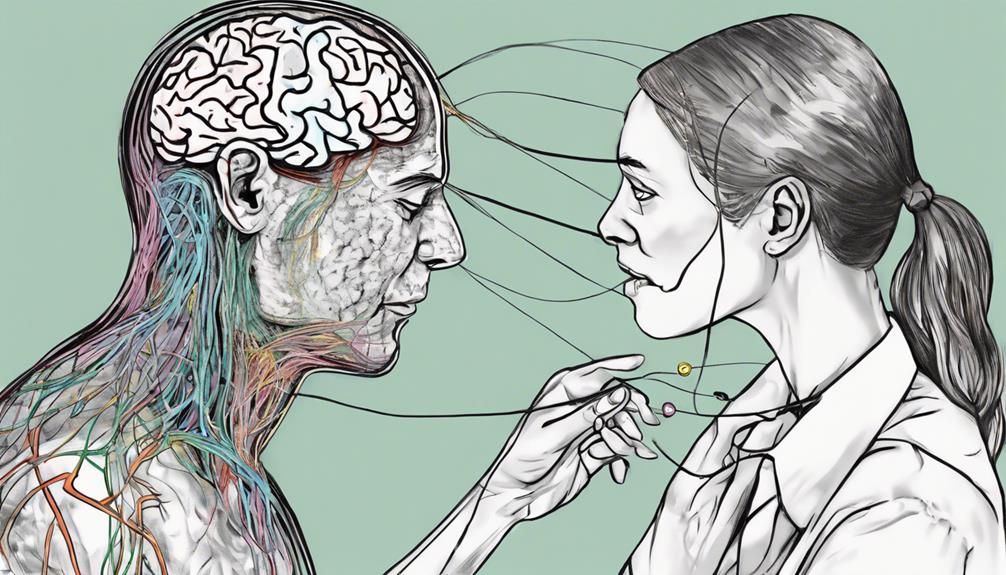Begin your journey with somatic therapy by initially focusing on body sensations and using breathing techniques to heighten awareness. Delve into the exploration of sensations connected to emotions, revealing deeper feelings and cultivating emotional resilience. Alleviate tension using specific strategies, such as profound breathing and grounding exercises. Apply movement and breath work to manage emotions and improve overall health. Establish a foundation of steadiness, safety, and connection to the present moment. Boost awareness of the body, aiding in the control of emotions and the modification of trauma-induced reactions. Progressively uncover the complex mind-body connection, embarking on a transformative path of healing and self-exploration.
Key Takeaways
- Start with grounding techniques to connect mind and body.
- Explore physical sensations and emotions through body scanning.
- Use deep breathing to regulate the nervous system.
- Address stored trauma energy with somatic experiencing.
- Cultivate body awareness and emotional regulation for healing.
Initial Body Awareness
To begin the somatic therapy process, start by bringing your attention to the physical sensations in your body. Take a moment to notice any areas of tension, discomfort, or relaxation. By using mindfulness techniques, you can explore these bodily sensations without judgment, focusing solely on the present moment experience.
As you become more aware, track any changes in your body sensations, such as shifts in tension, temperature, or movement. Incorporating deep breathing can further enhance your body awareness by connecting you with the rhythm of your breath and how it impacts your body.
Through this initial body awareness, you can start to identify patterns in how your body responds to different emotional situations. These patterns will lay the groundwork for deeper somatic work as you progress through the therapy process.
Exploring Sensations and Emotions

You'll begin by engaging in sensory exploration techniques to tune into the physical sensations present in your body.
Through emotional awareness exercises, you'll learn to connect these sensations with underlying feelings and experiences.
These practices help strengthen the body-mind connection, fostering a deeper understanding of your emotional landscape.
Sensory Exploration Techniques
Engage in sensory exploration techniques to investigate your body's sensations and emotions during somatic therapy sessions.
When you explore sensory experiences, you open a door to understanding the physical manifestations of emotions stored within you, perhaps stemming from a traumatic event.
By paying attention to your physical sensations like tension, relaxation, warmth, or coolness, you can uncover the underlying emotions tied to them.
This process not only fosters a deeper mind-body connection but also aids in processing and releasing these pent-up emotions.
Through this exploration, you pave the way for healing and the cultivation of resilience within yourself.
As you navigate through this journey of self-discovery, remember that each sensation and emotion carries valuable information that can guide you towards a more profound understanding of yourself and your experiences.
Embrace this opportunity to connect with your inner world and facilitate your growth and well-being.
Emotional Awareness Exercises
During somatic therapy sessions, explore emotional awareness exercises by investigating bodily sensations and connecting them to specific emotions. Clients are encouraged to pay attention to and articulate physical sensations in the body linked to various emotional states.
These exercises play a pivotal role in enhancing self-awareness and emotional processing. By delving into the relationship between sensations and emotions, individuals can deepen their understanding of the mind-body connection. This heightened awareness can aid in healing from past traumas and unresolved emotional issues.
Engaging in emotional awareness exercises fosters a more profound comprehension of how emotions manifest physically, leading to a more holistic approach to somatic therapy. Through these practices, clients develop the skills to recognize, acknowledge, and work through their emotions, promoting overall well-being and emotional resilience.
Emotional awareness exercises are a fundamental component of somatic therapy, facilitating a deeper exploration of the interconnectedness between bodily sensations and emotional experiences.
Body-Mind Connection Practices
Explore how body-mind connection practices in somatic therapy involve investigating the interplay between physical sensations and emotions to deepen self-awareness and emotional understanding.
In somatic therapy, the focus is on understanding how your body and mind communicate with each other. By tuning into physical sensations, you can uncover hidden emotions and triggers that manifest in your body.
Practitioners often use techniques like body scanning, where you pay close attention to each part of your body to identify areas of tension or discomfort that might be linked to emotional stress.
Mindful movement practices, such as gentle yoga or tai chi, help you connect with your body in a more conscious way, fostering a deeper awareness of the body-mind connection.
Releasing Tension and Discomfort

Start by focusing on tension release techniques that can help you unwind and relax your body.
Explore discomfort alleviation methods to address any physical or emotional unease you may be experiencing.
Tension Release Techniques
To release tension and discomfort effectively in somatic therapy, practitioners focus on guiding clients through specific techniques aimed at identifying and releasing stored physical tension in the body. By targeting areas of physical tension, somatic therapists assist individuals in alleviating discomfort and promoting relaxation.
Through gentle movements, breathing exercises, and enhancing body awareness, clients can recognize and release tension effectively. These tension release techniques play a pivotal role in somatic therapy by addressing the somatic components of emotional stress and trauma stored in the body.
As clients engage in these techniques, they begin to experience a sense of relief, improved body awareness, and reduced physical discomfort. The process involves a mindful exploration of the body to locate areas of tension and allow for their release, fostering a deeper connection between physical sensations and emotional well-being.
Through these practices, individuals can gradually release stored tension, promoting overall relaxation and well-being.
Discomfort Alleviation Methods
Guiding clients through techniques involving deep breathing, grounding exercises, and body scanning, somatic therapy effectively alleviates discomfort by targeting and releasing physical tension stored in the body.
Grounding exercises play a pivotal role in somatic therapy, helping individuals connect with their environment and reduce discomfort. By focusing on the senses and surroundings, grounding exercises aid in anchoring the individual in the present moment, easing physical tension and promoting relaxation.
Body scanning techniques further enhance the process by identifying specific areas of discomfort and tension within the body for targeted release. Through gentle movements, stretches, and heightened awareness of bodily sensations, somatic therapy guides individuals in releasing stored physical discomfort.
Breathing and Movement Techniques

Incorporating breathing and movement techniques is essential in somatic therapy to regulate your nervous system and promote relaxation. Breathing techniques such as deep diaphragmatic breathing are utilized to calm the body's stress response, increase oxygen intake, and reduce anxiety during somatic therapy sessions. These techniques help in releasing tension and aiding in emotional processing. Movement exercises like gentle stretching, shaking, or grounding movements are also integral in somatic therapy. These movements assist in promoting body awareness, reconnecting with the body, and facilitating the release of stored tension. By combining conscious breathing with purposeful movements, individuals can tune into their body's sensations and enhance overall well-being.
| Breathing Techniques | Movement Exercises | Benefits |
|---|---|---|
| Deep diaphragmatic breathing | Gentle stretching | Regulates nervous system |
| Shaking | Promotes emotional processing | |
| Grounding exercises | Releases tension |
Guided Touch and Regulation

Using gentle touch in somatic therapy involves the therapist guiding your body to release tension and promote relaxation. This form of therapy focuses on regulation techniques, where the therapist uses specific touch to help you regulate your nervous system and emotions effectively.
Here are three key aspects of guided touch and regulation in somatic therapy:
- Facilitating Grounding: Through touch, therapists can help you feel more grounded and connected to the present moment, fostering a sense of stability and security.
- Enhancing Body Awareness: Guided touch encourages you to become more aware of your body sensations and responses, promoting a deeper understanding of your physical and emotional experiences.
- Supporting Emotional Regulation: By using touch in a therapeutic manner, therapists assist you in regulating your emotions, fostering a safe space for processing and managing difficult feelings.
In the therapist-client interaction, touch is used to provide comfort, enhance safety, and deepen the connection between you and your body, ultimately promoting relaxation and emotional well-being in somatic therapy.
Rewiring Trauma Responses

To rewire trauma responses effectively in somatic therapy, focus shifts towards harnessing the body's wisdom and physical sensations. By tuning into physical sensations, somatic therapy helps regulate the nervous system and release stored trauma energy. Techniques such as grounding, pendulation, and resourcing are utilized to assist individuals in gradually processing traumatic memories. This approach acknowledges the body's innate ability to heal and seeks to reestablish a sense of safety and connection within the individual.
Somatic therapy aims to rewire trauma responses by addressing the mind-body feedback loop, promoting healing, and fostering resilience. Through working with the body's resources, this therapy modality offers a unique pathway to navigate and transform the impact of past traumatic experiences.
Cultivating Mind-Body Connection

Cultivating the mind-body connection in somatic therapy involves increasing your body awareness to recognize physical sensations and emotions.
Here are three key practices that can help you deepen this connection:
- Grounding Techniques: Grounding exercises assist in anchoring yourself in the present moment by focusing on the sensations in your body or your connection to the environment around you. This can help you feel more centered and connected.
- Deep Breathing: Engaging in deep breathing exercises can help regulate your nervous system, reduce stress, and increase your awareness of how emotions are reflected in your body. It promotes relaxation and aids in connecting with your physical experiences.
- Body Scans: Body scans involve systematically bringing attention to different parts of your body, noticing any tension, discomfort, or sensations present. This practice enhances your ability to tune into your body's signals and understand the connection between physical sensations and underlying emotions.
Progressively Addressing Emotions

Increase your emotional awareness by progressively tuning into bodily sensations associated with specific emotions in somatic therapy. Therapists guide you to recognize physical cues like tension, warmth, or tightness in different body areas linked to various emotions.
This process allows you to explore how emotions manifest physically, fostering a deeper understanding and connection to your feelings. By honing in on bodily experiences, you can effectively comprehend, process, and release pent-up emotions stemming from past traumas or current stressors.
Engaging in this gradual emotional exploration through somatic therapy can result in enhanced emotional regulation, increased resilience, and an overall sense of well-being. As you become more attuned to the relationship between your emotions and bodily sensations, you pave the way for significant progress in managing and addressing the emotional complexities that may be affecting your mental health.
Understanding Brain Rewiring Process

Understanding how the brain rewires itself during trauma healing processes is essential for effective somatic therapy outcomes.
When delving into the brain rewiring process in the context of trauma healing, several key aspects come into play:
- Neuroplasticity and Amygdala Connectivity: Trauma-related conditions like PTSD and chronic pain show heightened neuroplasticity and increased connections to the amygdala. These changes impact emotional regulation and overall well-being.
- Physiological Dysregulation and Autonomic Nervous System: Dysregulation of the autonomic nervous system can lead to various symptoms affecting daily life. Addressing physiological dysregulation is pivotal in trauma healing to alleviate symptoms like dizziness, fatigue, and changes in heart rate.
- Frontal Cortex Shutdown and Symptom Manifestation: Shutdown of the frontal cortex and increased amygdala connectivity during trauma situations contribute to dysregulation and symptom manifestation. By targeting these areas through somatic therapy, individuals can work towards rewiring their brains for better emotional and physical health.
Frequently Asked Questions
How Is Somatic Therapy Done?
To experience somatic therapy, you engage in body-centered techniques that release stored emotions and trauma. Therapists guide you to tune into body sensations, track emotions, and regulate nervous system responses. Techniques like grounding, pendulation, and titration help you process trauma.
How to Begin Somatic Therapy?
To begin somatic therapy, connect with a qualified therapist. Establish trust, share goals, and engage in body awareness exercises. Explore stored emotions through somatic techniques. Prioritize building a safe therapeutic relationship before delving into deeper work.
What Is the Somatic Methodology?
In somatic therapy, the methodology involves addressing the mind-body connection to heal trauma and release stored emotions. Therapists focus on physical sensations, body awareness, and nervous system regulation for emotional healing, promoting safety and resilience.
How Do You Do Somatic?
To do somatic therapy, you tune into bodily sensations, track emotions, and release tension. By integrating body awareness and emotional processing, healing occurs. Grounding and resourcing techniques help regulate responses, promoting resilience.
Conclusion
In somatic therapy, you take a journey within yourself, exploring sensations, emotions, and releasing tension.
By connecting your mind and body, you can rewire trauma responses and cultivate healing.
Remember, this process is like a delicate dance between your past and present, guiding you towards a brighter future.
So take each step with courage and compassion, knowing that every breath and movement brings you closer to wholeness.










